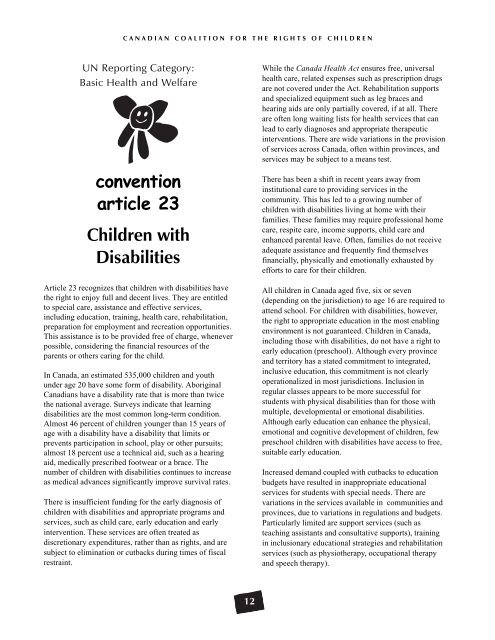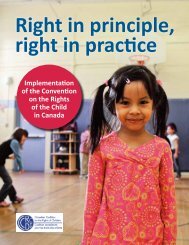Poste - Canadian Coalition for the Rights of Children
Poste - Canadian Coalition for the Rights of Children
Poste - Canadian Coalition for the Rights of Children
Create successful ePaper yourself
Turn your PDF publications into a flip-book with our unique Google optimized e-Paper software.
C A N A D I A N C O A L I T I O N F O R T H E R I G H T S O F C H I L D R E N<br />
UN Reporting Category:<br />
Basic Health and Welfare<br />
convention<br />
article 23<br />
<strong>Children</strong> with<br />
Disabilities<br />
Article 23 recognizes that children with disabilities have<br />
<strong>the</strong> right to enjoy full and decent lives. They are entitled<br />
to special care, assistance and effective services,<br />
including education, training, health care, rehabilitation,<br />
preparation <strong>for</strong> employment and recreation opportunities.<br />
This assistance is to be provided free <strong>of</strong> charge, whenever<br />
possible, considering <strong>the</strong> financial resources <strong>of</strong> <strong>the</strong><br />
parents or o<strong>the</strong>rs caring <strong>for</strong> <strong>the</strong> child.<br />
In Canada, an estimated 535,000 children and youth<br />
under age 20 have some <strong>for</strong>m <strong>of</strong> disability. Aboriginal<br />
<strong>Canadian</strong>s have a disability rate that is more than twice<br />
<strong>the</strong> national average. Surveys indicate that learning<br />
disabilities are <strong>the</strong> most common long-term condition.<br />
Almost 46 percent <strong>of</strong> children younger than 15 years <strong>of</strong><br />
age with a disability have a disability that limits or<br />
prevents participation in school, play or o<strong>the</strong>r pursuits;<br />
almost 18 percent use a technical aid, such as a hearing<br />
aid, medically prescribed footwear or a brace. The<br />
number <strong>of</strong> children with disabilities continues to increase<br />
as medical advances significantly improve survival rates.<br />
There is insufficient funding <strong>for</strong> <strong>the</strong> early diagnosis <strong>of</strong><br />
children with disabilities and appropriate programs and<br />
services, such as child care, early education and early<br />
intervention. These services are <strong>of</strong>ten treated as<br />
discretionary expenditures, ra<strong>the</strong>r than as rights, and are<br />
subject to elimination or cutbacks during times <strong>of</strong> fiscal<br />
restraint.<br />
12<br />
While <strong>the</strong> Canada Health Act ensures free, universal<br />
health care, related expenses such as prescription drugs<br />
are not covered under <strong>the</strong> Act. Rehabilitation supports<br />
and specialized equipment such as leg braces and<br />
hearing aids are only partially covered, if at all. There<br />
are <strong>of</strong>ten long waiting lists <strong>for</strong> health services that can<br />
lead to early diagnoses and appropriate <strong>the</strong>rapeutic<br />
interventions. There are wide variations in <strong>the</strong> provision<br />
<strong>of</strong> services across Canada, <strong>of</strong>ten within provinces, and<br />
services may be subject to a means test.<br />
There has been a shift in recent years away from<br />
institutional care to providing services in <strong>the</strong><br />
community. This has led to a growing number <strong>of</strong><br />
children with disabilities living at home with <strong>the</strong>ir<br />
families. These families may require pr<strong>of</strong>essional home<br />
care, respite care, income supports, child care and<br />
enhanced parental leave. Often, families do not receive<br />
adequate assistance and frequently find <strong>the</strong>mselves<br />
financially, physically and emotionally exhausted by<br />
ef<strong>for</strong>ts to care <strong>for</strong> <strong>the</strong>ir children.<br />
All children in Canada aged five, six or seven<br />
(depending on <strong>the</strong> jurisdiction) to age 16 are required to<br />
attend school. For children with disabilities, however,<br />
<strong>the</strong> right to appropriate education in <strong>the</strong> most enabling<br />
environment is not guaranteed. <strong>Children</strong> in Canada,<br />
including those with disabilities, do not have a right to<br />
early education (preschool). Although every province<br />
and territory has a stated commitment to integrated,<br />
inclusive education, this commitment is not clearly<br />
operationalized in most jurisdictions. Inclusion in<br />
regular classes appears to be more successful <strong>for</strong><br />
students with physical disabilities than <strong>for</strong> those with<br />
multiple, developmental or emotional disabilities.<br />
Although early education can enhance <strong>the</strong> physical,<br />
emotional and cognitive development <strong>of</strong> children, few<br />
preschool children with disabilities have access to free,<br />
suitable early education.<br />
Increased demand coupled with cutbacks to education<br />
budgets have resulted in inappropriate educational<br />
services <strong>for</strong> students with special needs. There are<br />
variations in <strong>the</strong> services available in communities and<br />
provinces, due to variations in regulations and budgets.<br />
Particularly limited are support services (such as<br />
teaching assistants and consultative supports), training<br />
in inclusionary educational strategies and rehabilitation<br />
services (such as physio<strong>the</strong>rapy, occupational <strong>the</strong>rapy<br />
and speech <strong>the</strong>rapy).




